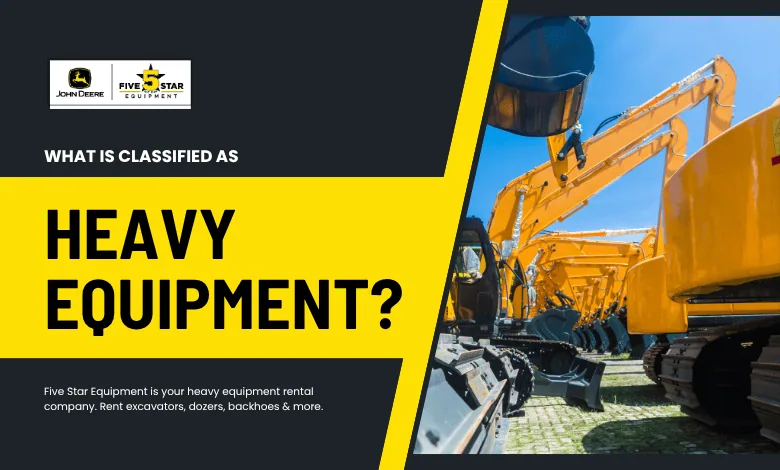What is Classified as Heavy Equipment?

In construction, agriculture, mining, and infrastructure development, the right tools make all the difference. Among the most essential tools are the powerful machines known for their capacity to move earth, lift enormous loads, and shape entire landscapes. But what exactly qualifies a machine to be considered heavy equipment? In this article, we’ll explore the characteristics, categories, and regulatory definitions that help determine what falls under this classification.
What Defines Large-Scale Machinery?
Large-scale machinery includes machines that are built to perform demanding physical tasks, often in rugged or hazardous environments. These machines are characterized by their sheer size, high horsepower, and specialized capabilities. The term is often used interchangeably with industrial or construction machinery, but its specific definition can vary depending on industry, region, and regulatory context.
Generally, machines that exceed a certain weight—commonly over 10,000 pounds—are considered part of this category. However, weight alone isn’t the only factor. The purpose of the machine, the level of power it requires, and the work environment all play a role in determining whether a machine qualifies.
Main Categories of Industrial Machinery
Large machinery serves a wide variety of purposes across multiple industries. Each type is designed for specific functions, and classification is typically based on its role rather than its size alone.
Earthmoving Equipment
Earthmoving machines are used to dig, push, and remove soil and rock. These machines are staples on construction sites and in mining operations.
- Excavators: Equipped with long arms and buckets, these machines are ideal for trenching and digging.
- Bulldozers: Known for their large front blades, they are used to move soil, sand, and rubble.
- Graders: These machines level surfaces and are often used in road construction.
Material Handling Machines
These machines focus on transporting, lifting, and stacking materials on job sites, in warehouses, and across industrial facilities.
- Forklifts: Common in warehouses, forklifts move pallets and other heavy goods.
- Telehandlers: Featuring extendable arms, they reach materials that are higher or farther away.
- Cranes: Tower cranes, mobile cranes, and truck-mounted cranes lift and move large loads vertically and horizontally.
Road and Infrastructure Equipment
Machines in this category are essential for the construction and maintenance of roads, bridges, and tunnels.
- Pavers: Lay asphalt for new road surfaces.
- Rollers: Compact soil and asphalt, ensuring structural stability.
- Concrete Pumps: Transport and pour concrete efficiently on large-scale projects.
Agricultural and Forestry Equipment
Agriculture and forestry involve unique machines that share the durability and size of those in the construction sector.
- Tractors: Versatile and powerful, used for plowing, planting, and towing implements.
- Harvesters: Automatically collect crops or logs, often with onboard processing capabilities.
- Skidders: Drag cut timber to collection sites in forestry operations.
Regulatory Standards and Industry Definitions
In many cases, the classification of a machine is tied directly to legal or industry standards. These standards ensure safety, environmental compliance, and operational efficiency.
OSHA and Workplace Safety
In the United States, the Occupational Safety and Health Administration (OSHA) provides regulations that outline safe operation practices for large machinery. Machines are often grouped by their potential to cause harm if improperly used.
Operators must be trained and certified, and the machines themselves must include safety features such as rollover protection systems (ROPS), secure enclosures, and hazard signage.
EPA Emission Standards
The Environmental Protection Agency (EPA) categorizes engines used in industrial machines and sets emissions thresholds. Diesel-powered machinery is often subject to “Tier 4” emission standards, designed to limit air pollutants such as nitrogen oxides and particulate matter.
Machines that do not meet these emission requirements are either retrofitted or phased out of use in favor of newer models.
Department of Transportation Restrictions
For machines that are transported on public roads, classification also depends on whether the equipment meets width, height, and weight regulations. Oversized machinery may require special transport permits or escort vehicles to comply with road safety laws.
When Does a Machine Become Heavy-Duty?
Not every large machine is classified under the umbrella of heavy equipment. The key distinction lies in the workload the machine is designed to handle. For example:
- A compact tractor may be ideal for small farms but wouldn’t be classified the same way as a high-horsepower combine harvester.
- A mini excavator used for backyard landscaping won’t fall into the same category as a full-size hydraulic excavator used on highway construction.
The level of exertion, the type of attachments, and the scale of the job all contribute to how a machine is categorized.
Ownership vs. Rental Considerations
Because of their size and cost, large-scale machines are often leased or rented instead of owned outright. Several factors can influence this decision:
- Project duration: Temporary projects may not justify the purchase of expensive equipment.
- Maintenance responsibilities: Owning machinery means handling repairs and preventive upkeep, while rental companies often cover these tasks.
- Financial flexibility: Renting or leasing reduces upfront costs and may allow businesses to access the latest models with modern features.
Many rental fleets include a broad range of machines, from cranes to loaders, making it easier for companies to match equipment with project needs.
Best Practices for Use and Maintenance
Whether owned or rented, large machinery demands careful management to ensure safety and productivity. Here are essential practices to follow:
Operator Certification
Only trained and certified personnel should operate these machines. Certification programs ensure that operators understand how to use equipment safely, perform pre-use inspections, and respond in emergencies.
Preventive Maintenance
Routine maintenance extends equipment life and improves reliability. This includes checking fluid levels, inspecting hydraulic systems, and replacing worn-out components. Many companies use digital logs to track service intervals and repairs.
On-Site Safety Protocols
Work sites must have clear safety rules for operating large machines. This includes designated work zones, proper use of signaling systems, and required personal protective equipment (PPE) such as hard hats, steel-toe boots, and high-visibility clothing.
Technological Advancements
The world of industrial machinery is evolving rapidly, thanks to technology. Modern machines are now equipped with:
- GPS and Telematics: These systems provide real-time data on fuel usage, engine performance, and machine location.
- Automation: Some machines now feature semi-autonomous functions, allowing operators to perform repetitive tasks more efficiently.
- Electric Powertrains: With sustainability in focus, some newer machines use electric motors or hybrid systems to reduce emissions.
These advances not only improve productivity but also contribute to environmental responsibility and lower operational costs.
Real-World Applications
Understanding which machines fall into this category is helpful across a variety of industries:
- Construction Firms: Use large-scale machinery for site preparation, grading, and structural assembly.
- Agricultural Operations: Employ tractors and harvesters for high-yield farming.
- Mining Companies: Rely on drilling machines and haul trucks to extract minerals.
- Municipal Services: Use snowplows, graders, and dump trucks for public works projects.
Each industry has unique demands, and classification helps professionals choose the right tool for each job.
Conclusion
So, what is classified as heavy equipment? It’s not just about size—it’s about function, power, and the environment in which the machine operates. From towering cranes to earth-moving bulldozers, the machines that fall under this category are engineered for endurance, efficiency, and extreme conditions. While regulatory bodies provide structure to these definitions, practical usage and industry standards further refine them.
Whether you’re managing a construction project, maintaining farmland, or overseeing public works, recognizing the types of machines that qualify as heavy equipment helps ensure that tasks are completed safely and effectively. By understanding the distinctions, investing in the right tools, and following best practices, professionals can get the job done—no matter how big.






